8th King's Royal Irish Hussars
| 8th (King's Royal Irish) Hussars | |
|---|---|
Prince Philip |
The 8th King's Royal Irish Hussars was a cavalry regiment in the British Army, first raised in 1693. It saw service for three centuries including the First and Second World Wars. The regiment survived the immediate post-war reduction in forces, and went on to distinguish itself in the battles of the Korean War, but was recommended for amalgamation in the 1957 Defence White Paper prepared by Duncan Sandys. The regiment was amalgamated with the 4th Queen's Own Hussars, to form the Queen's Royal Irish Hussars in 1958.
History
Formation and War of Spanish Succession
The regiment was first raised by
The regiment took part in a skirmish near Tanarite at which Henry Conyngham was killed: Robert Killigrew took over but was also killed at the Battle of Almansa in April 1707. Under their new colonel, John Pepper, the 8th Dragoons routed a Spanish cavalry regiment at the Battle of Almenar in July 1710, and, according to tradition, took possession of the enemy regiment's crossbelts. This earned the regiment the nickname "Crossbelt Dragoons", borne for many years. The regiment was captured in its entirety at the Battle of Brihuega in December 1710.[3]
Disbandment and reformation (1713–1796)
The regiment returned home and was disbanded in 1714. It was re-raised again in 1715 and deployed to Scotland as part of the response to the
South Africa, India and peace (1796–1854)
The regiment deployed to South Africa to control the
Crimean War

Robert Richard Scanlan
During the
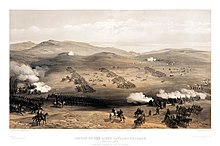
In October, Balaklava and the
The pace of our Cavalry increased every moment, until they went thundering along the valley, making the ground tremble beneath them. On they went headlong to death, disregarding aught but the object of their attack. At length they arrived at the guns, their numbers sadly thinned, but the few that remained made fearful havoc amongst the enemy's artillery.[3]
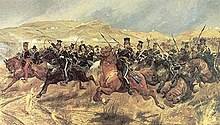
As part of the second wave of the brigade's attack, the 8th were in line with the 4th Light Dragoons and, advancing in support at a steady pace, came under fire. Wounded men and horses from the leading squadrons kept dashing out, making the lines unsteady. With the pace increasing, the 4th were not checked by their officers and the lines separated. In spite of the fall of men and horses, the regiment passed the remains of the battery in the valley.[6] The 8th pushed through the line of Russian gunners to the remnants of the first line in retreat, unaware that a Russian brigade of light cavalry was at hand. A regiment of Russian lancers was advancing from behind, as the 8th Hussars went through the infantry crossfire and lost half their men. The remnants of the brigade formed up, totalling about 70 men. They decided to attack the Russian lancers, eventually overthrowing them. The ground was now opened up for the brigade to retire, the 8th now pursued their course to their original position, followed by all the other horsemen of the other regiments and, as their horses became blown or wounded, they tailed. The Russians were now recovering in confidence and they pursued the dismounted men. The officers of the 8th called off the men, freeing up the ground for artillery fire, which gave many the chance to escape. Overall, two officers and 19 other ranks were killed and two officers and 18 other ranks were wounded. One officer and seven other ranks were taken prisoner-of-war.[7]
The Battle of Inkerman was won by the infantry in November as the harsh winter of 1854–55 set in, killing 9,000 men. However, the loss of these men did not stop the 8th Hussars from overcoming the Russians at Kertch. In September 1855, Sevastopol fell after nearly a year, and a peace treaty was signed in March 1856.[3]
Of the 293 other ranks who had set out for the
Indian Rebellion of 1857
The 8th spent a year in England but were called to India to help suppress the
War-Office, 26 January 1859.
THE Queen has been graciously pleased to confirm the grant of the Decoration of the Victoria Cross to the undermentioned Officer, Non-Commissioned Officer, Farrier, and Private of Her Majesty's 8th Hussars, which decoration has been provisionally conferred upon them by Major-General Sir Hugh Henry Rose, G.C.B., Commanding the Central India Field Force, in accordance with the rules laid down in Her Majesty's Warrant instituting the same, on account of an Act of Bravery performed by them in India, as recorded against their several names, viz.:
Captain (now Brevet-Major) Clement Walker Heneage, No. 1584. Serjeant Joseph Ward, No. 1298. Farrier George Hollis, No. 861. Private John Pearson
Date of Act of Bravery, 17 June 1858.
Selected for the Victoria Cross by their companions in the gallant charge made by a squadron of the Regiment at Gwalior, on 17 June 1858, when, supported by a division of the Bombay Horse Artillery and Her Majesty's 95th Regiment, they routed the enemy, who were advancing against Brigadier Smith's position, charged through the rebel camp into two batteries, capturing and bringing into their camp two of the enemy's guns, under a heavy and converging fire from the Fort and Town.
(Field Force Orders by Major-General Sir Hugh Henry Rose, G.C.B., Commanding Central India Field Force, dated Camp, Gwalior, 28 June 1858.)
The remaining year of the Mutiny consisted of the pursuit of the rebel forces. On 5 September 1858, a squadron of "D" Troop, 8th Hussars, caught the mutineers at
Ireland
The 8th Hussars were based at the
The future Field Marshal Sir
Afghanistan and Second Boer War (1863–1914)


The regiment returned to India in 1879 and then moved on to Afghanistan to bolster Lord Roberts' army, which was engaged in the Second Anglo-Afghan War; the regiment returned home in 1889.[3]
In October 1899, war broke out between the United Kingdom and the Boer republics in South Africa. The regiment sailed to South Africa on the SS Norseman in February 1900, arriving in
During the later phases of the war, the
After returning to England, the 8th had over six years without hostilities before returning to India in August 1914 arriving at
First World War
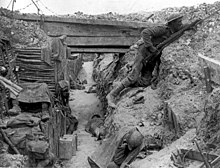
The 8th Hussars entered

The majority of the casualties occurred from the unsanitary conditions of the trenches, the cavalry being held almost exclusively in reserve, waiting for "the gap" constantly warned off, but never used. In July 1916, the King's Royal Irish Hussars fought at

In March 1918, they were transferred to the
Inter-war
The 8th Hussars returned to England in 1919, and embarked almost immediately for India where they spent less than a year. They were soon ordered to Mesopotamia in order to deal with various native insurrections at Medali, which they put down, moving from there to Egypt. The regiment retitled as the 8th King's Royal Irish Hussars in 1921.[1] In 1923, the Regiment moved back to York and completed a three-year tour as part of the occupation forces in Germany from 1926 to 1929. They then returned to Aldershot, and received their first motorised transport for the machine-gun squadron. In 1934, the 8th moved to Abassia in Egypt. Their particular brand of soldiering was at an end after 242 years; the King's Royal Irish Hussars had their horses replaced with 15 Cwt Ford V8 pick-up trucks mounted with Vickers Berthier machine guns.[24] The last mounted parade was held at Coombe Hill in the desert near Cairo on 11 November 1935 where the three sabre squadrons and the mounted band "trotted past, wheeled and galloped" for the GOC, Army of the Nile.[24] In 1936, the regiment helped quell civil unrest in Palestine and then returned to Egypt as part of the Matruh Mobile Force.[3]
Second World War
The Desert War

In 1938, the regiment was transferred to the Light Cavalry Brigade of the Mobile Division, (The Matruh Mobile Force)
The regiment was part of the offensive against the

In July 1941, the 8th Hussars, in
Normandy and beyond

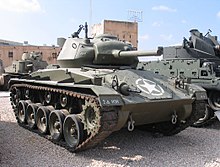


On its return from North Africa, the regiment was re-equipped with
Korean War

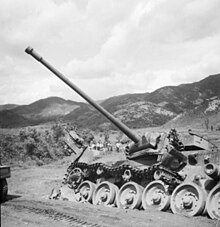
In 1948, the 8th returned to
Astley-Cooper was last seen dismounting his brewed up Cromwell and running away with his loader. His subsequent fate is unknown. In February, the
Captain Ormrod's tanks had forced their way down the last lap of the valley through milling Chinamen. They could see what was estimated at 2,000 more, swarming down the western hillsides, from the heights where they had been held up all day. The Centurions came through, crushing enemy under their tracks. Sgt. Cadman found a Chinaman battering at his turret to get in, and directed the tank straight through the wall of a house, to brush him off, and then ran over an M.G. post beside the road. Cornet Venner, who had behaved with great gallantry at every stage of the day's fighting, lost his scout-car, but guided one Centurion out of trouble and escaped, wounded, himself. Captain Ormrod was wounded in the head by a grenade. Three platoons of Infantry suddenly appeared, in parade-ground order, out of the river bed – and were blown to confusion with some of the last ammunition the tanks carried. Some tanks took to the paddy and were ploughing-in Communists, crouched under every bank. The firing was a continuous iron rain on the outside of the tanks, and only a small proportion of the Infantry on the top survived this death-ride. The tanks came out of the valley to see the
Belgians leaving their ridge, that all day had guarded this southern opening.[51]
Richard Napier, (a tank commander in the battle) in his book From Horses to Chieftains recalls: "After about three hours of continuous firing, my machine gun barrels needed changing; my recoil system was so hot that it wouldn't run back and my loader/operator Ken Hall, had fainted with the continual hard work and fumes."[52]
Napier relates how, unable to use his weapons, he withdrew, allowing infantrymen to hitch a ride on his tank. The Chinese had infiltrated behind them and were swarming around them, shooting at the infantrymen on the tank. The crew resorted to lobbing grenades out of the hatches at the mass of Chinese infantry.[53] On one occasion, the
"It was at the Battle of the Imjin River in April 1951 that the Centurions of the 8th Hussars won lasting fame when their tanks covered the withdrawal of the 29th Brigade in heroic fashion in the face of the overwhelming Chinese Spring Offensive".[55]
Amalgamation

Between 1952 and 1958 the 8th King's Royal Irish Hussars soldiered in Lüneburg enjoying an extended period of peace. In the 1957 Defence White Paper, the 8th Hussars were slated for reduction. In 1958, the Regiment was amalgamated with the 4th Queen's Own Hussars to form the Queen's Royal Irish Hussars.[1]
Regimental museum
The regimental collection is moving to a new facility in Warwick known as "Trinity Mews": it is due to open in 2018.[56]
Battle honours
The 8th Hussars received a number of
- Early wars: Leswaree, Hindoostan, Alma, Balaklava, Inkerman, Sevastopol, Afghanistan 1879–80, South Africa 1900–02
- First World War: Givenchy 1914, Amiens 1918, Albert 1918, Beaurevoir, Pursuit to Mons, France and Flanders 1914–1918
- Second World War: Villers Bocage, Mont Pincon, Dives Crossing, Nederrijn, Best, Lower Maas, Roer, Rhine, North Africa 1940–42,
- Korean War: Seoul, Hill 327, Imjin, Kowang-San, Korea 1950–51
Notable personalities
- Field Marshal Sir John French, 1st Earl of Ypres
- General Sir Robert "Rollo" Gillespie1766–1814
- General Sir John Hackett (British Army officer)
- Lieutenant General James Brudenell, 7th Earl of Cardigan
- Lieutenant the Hon. John Charles Henry Fitzgibbon (only son of the 3rd Earl of Clare). Killed in action at Balaklava
- ISBN 0-7509-4534-6
Regimental colonels

Colonels of the Regiment were:[1]
- 1693–1706: Maj-Gen. Henry Conyngham
- 1706–1707: Maj-Gen. Robert Killigrew
- 1707–1714: Maj-Gen. John Pepper
- disbanded 1714
- John Pepper's Regiment of Dragoons - (reformed 1715)
- 1715–1716: Maj-Gen. John Pepper (reappointed)
- disbanded 1716
- Phineas Bowles's Regiment of Dragoons - (reformed 1719)
- 1719–1722: Maj-Gen. Phineas Bowles (senior)
- 1722–1725: Brig-Gen. Richard Munden
- 1725–1731: F.M. Sir Robert Rich, 4th Bt
- 1731–1733: Maj-Gen. Charles Cathcart, 8th Baron Cathcart
- 1733–1736: Brig-Gen. Sir Adolphus Oughton, Bt
- 1737–1740: Lt-Gen. Clement Neville
- 1740–1755: Lt-Gen. Richard St George
- 8th Regiment of Dragoons - (1751)
- 1755–1758: Gen. John Waldegrave, 3rd Earl Waldegrave
- 1758–1760: Gen. Sir Joseph Yorke, 1st Baron Dover, KB
- 1760–1787: Gen. John Severne
- 8th (The King's Royal Irish) Regiment of (Light) Dragoons - (1777)
- 1787–1789: Gen. Charles Grey, 1st Earl Grey, KB
- 1789–1797: Gen. Francis Lascelles
- 1797–1788: Gen. Charles Grey, 1st Earl Grey, KB (reappointed)
- 1799–1804: Gen. Sir Robert Laurie, Bt
- 1804–1818: Gen. Sir John Floyd, Bt
- 1818–1833: Gen. Sir Banastre Tarleton, Bt., GCB
- 8th (The King's Royal Irish) Regiment of (Light) Dragoons (Hussars) - (1822)
- 1833–1839: Gen. Sir William Kerr Grant, KCB, GCH
- 1839–1840: Lt-Gen. Sir Joseph Straton, CB, KCH
- 1840–1843: Lt-Gen. Philip Philpot
- 1843–1855: Gen. Sir John Brown, KCH
- 1855–1865: F.M. George Charles Bingham, 3rd Earl of Lucan, GCB
- 8th (The King's Royal Irish) Hussars - (1861)
- 1865–1868: Gen. John Lawrenson
- 1868–1875: Gen. John Charles Hope Gibsone
- 1875–1880: Lt-Gen. Rudolph de Salis, CB
- 1880–1886: Gen. William Charles Forrest, CB
- 1886–1886: Lt-Gen. Sir James Robertson Steadman Sayer, KCB
- 1886–1895: Lt-Gen. Sir Charles Craufurd Fraser, Bt., VC, KCB
- 1895–1910: Maj-Gen. William Mussenden
- 1910–1930: Gen. Sir Bryan Thomas Mahon, KCB, KCVO, DSO
- 8th King's Royal Irish Hussars - (1921)
- 1930–1948: Brig. John van der Byl, DSO
- 1948–1958: Col. (Air Marshal) Sir John Eustace Arthur Baldwin, KBE, CB, DSO
See also
References
- ^ a b c d e f g h i j k "8th King's Royal Irish Hussars". regiments.org. Archived from the original on 3 March 2007. Retrieved 13 August 2016.
- ^ A Military Dictionary, William Duane. 1810 p 140
- ^ a b c d e f g h i j k l m n "History, 8th Kings's Royal Irish Hussars". Queen's Royal Hussars. Archived from the original on 16 June 2008. Retrieved 13 August 2016.
- ^ "Lives of the Light Brigade: 8th Hussars to the Crimea 1854". The James Boys Archive. Archived from the original on 14 May 2008. Retrieved 22 May 2008.
- ^ "Lives of the Light Brigade: 8th Hussars in the Crimea". The James Boys Archive. Archived from the original on 17 May 2008. Retrieved 22 May 2008.
- ^ "The Crimea". Digger History. Archived from the original on 23 May 2008. Retrieved 22 May 2008.
- ^ "Lives of the Light Brigade: 8th Hussars in the Charge". The James Boys Archive. Archived from the original on 17 May 2008. Retrieved 22 May 2008.
- ^ "Lives of the Light Brigade: 8th Hussars after Balaklava". The James Boys Archive. Archived from the original on 17 May 2008. Retrieved 22 May 2008.
- ^ Original Warrant, Clause 13: "Thirteenthly. It is ordained that in the event of a gallant and daring act having been performed by a squadron, ship's company, or detached body of seamen and marines not under 50 in number, or by a brigade, regiment, troop or company in which the admiral, general, or other officer commanding such forces may deem that all are equally brave and distinguished, and that no special selection can be made by them, then is such case the admiral, general, or other officer commanding, may direct that for any such body of seamen or marines, or for every troop or company of soldiers, one officer shall be selected by the officers engaged for the Decoration, and in like manner one petty officer or non-commissioned officer shall be selected by the petty officers and non-commissioned officers engaged, and two seamen or private soldiers or marines shall be selected by the seamen, or private soldiers, or marines engaged, respectively for the Decoration, and the names of those selected shall be transmitted by the senior officers in command of the Naval force, brigade, regiment, troop, or company, to the admiral or general officer commanding, who shall in due manner confer the Decoration as if the acts were done under his own eye." From "No. 21846". The London Gazette. 5 February 1856. p. 411.
- ^ "No. 22223". The London Gazette. 28 January 1859. p. 294.
- ^ Niall Fallon, 'A rare medal is unearthed on Curragh' in The Irish Times, 21 May 1994, p.22
- ^ "Victoria Cross daredevil who helped crush Indian Mutiny". Halifax Courier. 13 December 2011. Archived from the original on 27 September 2013. Retrieved 13 August 2016.
- ^ "No. 24074". The London Gazette. 10 March 1874. p. 1591.
- ^ Holmes 2004, pp.20-2
- ^ "Latest intelligence - The War - Movements of Transport". The Times. No. 36087. London. 12 March 1900. p. 5.
- ^ "8th King's Royal Irish Hussars". Anglo-Boer War. Retrieved 13 August 2016.
- ^ "BOERS BADLY DEFEATED; Lose Seven Guns, Twenty-three Dead, and Many Captured. Fight Was Near Bothaville with De Wet and Steyn's Forces -- British Colonel Killed". New York Times. 10 November 1900. Retrieved 22 May 2008.
- ^ "Kwazulu Natal Branch; Newsletter No. 342". South African Military History Society. 10 January 2004. Retrieved 22 May 2008.
- ^ Wilson, H. W. (1901). With the Flag to Pretoria: A History of the Boer War, 1899–1900. Harmsworth Brothers, London. pp. Chapter XXV. Archived from the original on 15 May 2008. Retrieved 18 May 2008.
- ^ a b "The Hussars". The Long, Long Trail. Retrieved 13 August 2016.
- ^ a b Patterson, Ian. "Armoured Regiments: 8th (King's Royal Irish) Hussars". Affiliated to Desert Rats Memorial Trust. Archived from the original on 16 May 2008. Retrieved 22 May 2008.
- ^ Becke 1935, p. 5
- ^ "QRH soldiers remember fallen comrade". Ministry of Defence. 11 November 2013. Archived from the original on 5 May 2016. Retrieved 13 August 2016.
- ^ a b Napier 1992, p. 61
- ^ Napier 1992, p. 122
- ^ Napier 1992, pp. 131–132
- ^ Napier 1992, p. 134
- ^ Napier 1992, p. 140
- ^ Napier 1992, p. 159
- ^ Napier 1992, p. 165
- ^ Napier 1992, p. 174
- ^ Napier 1992, p. 179
- ^ Unit histories—Lt Col Gerald "Smash" Kilkelly Archived 4 October 2008 at the Wayback Machine
- ^ Napier 1992, p. 187
- ^ Bellamy 2005, p. 16
- ^ Bellamy 2005, pp. 18–20
- ^ Bellamy 2005, p. 127
- ^ Bellamy 2005, p. 167
- ^ Bellamy 2005, p. 183
- ^ "Lt-Col Wingate Charlton". The Daily Telegraph. London. 15 November 2007. Retrieved 23 April 2010.
- ^ "General Sir Desmond Fitzpatrick". The Daily Telegraph. London. 18 October 2002. Retrieved 23 April 2010.
- ^ Fallingbostel Military Museum
- ^ Bellamy 2005, p. 227
- ^ Napier 1992, p. 239
- ^ Napier 1992, pp. 255–256
- ^ ISBN 9781855322974
- ^ Captain Donald Lewis Astley-Cooper: Mosley, Charles, editor. Burke's Peerage, Baronetage & Knightage, 107th edition, 3 volumes. Wilmington, Delaware, U.S.A.: Burke's Peerage (Genealogical Books) Ltd, 2003.
- ^ Napier 1992, p. 269
- ^ Napier 1992, p. 271
- ^ a b "Colonel Peter Ormrod". The Times. London. 1 November 2007. Retrieved 23 April 2010.
- ^ a b c "The Korean Supplement of "Crossbelts", Regimental Journal". 8th King's Royal Irish Hussars. Retrieved 13 August 2016.
- ^ Napier 1992, p. 280
- ^ Napier 1992, pp. 280–281
- ^ Paul, James; Spirit, Martin. "Gloster Hill". Britain's Small Wars. Archived from the original on 27 May 2008. Retrieved 22 May 2008.
- ISBN 978-1-84176-387-3
- ^ "More about the New Museum". The Queen's Own Hussars Museum. Retrieved 11 June 2018.
Bibliography
- Becke, Major A.F. (1935). Order of Battle of Divisions Part 1. The Regular British Divisions. London: His Majesty's Stationery Office. ISBN 1-871167-09-4.
- OCLC 226088643.
- Holmes, Richard (2004) [1981]. The Little Field Marshal: A Life of Sir John French. Weidenfeld & Nicolson. ISBN 0-297-84614-0.
- Napier, Richard (1992). From Horses to Chieftains: My Life with the 8th Hussars. Woodfield Publishing. OCLC 656144994.
External links
- Regimental Association (as the regiment is now part of the Queen's Royal Hussars, the Association is also merged)
- "War Diary of 8th Kings Royal Irish Hussars".
